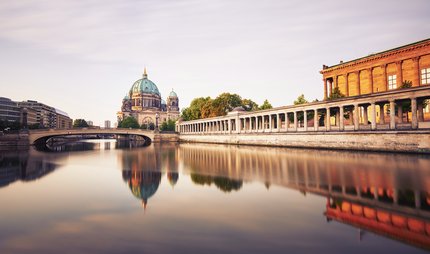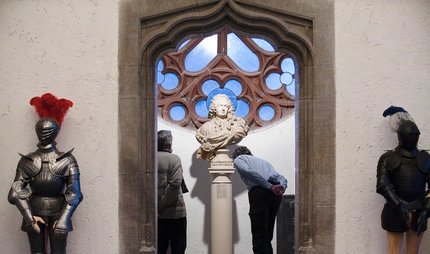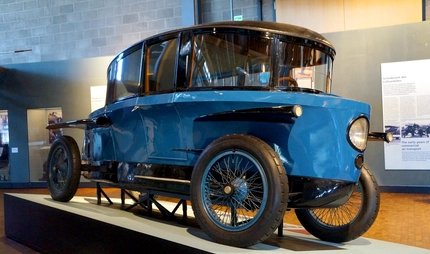
Museum für Kommunikation Berlin (Museum for Communication)
Hand axes and robots under one roof
What is communication and how does it affect our lives? Responses to these exciting questions are found at Berlin's museum for communication, the oldest Postal Museum in the world, with a focus on the complex changes of the information society. From Morse code to interactive robots, its exhibits tell the story of communication in vivid and tangible terms.
Experimenting with communication at the 'Postkolosseum'
The Museum für Kommunikation forms part of the Museum Foundation for post and telecommunications. Its predecessor is the Postal Museum. Emperor Wilhelm I opens the 1874 building which houses a collection charting the history of the postal system. In 1895, Ernst Wenck completes a sculpture of giants spanning the globe, symbolising the importance of the postal service for mankind, it is seen on the roof. The imposing appearance of the giants lead Berliners to jokingly refer to the building as the 'Post Colosseum'. Bombing raids destroy large parts of the premises during the Second World War. During the 1950s, the GDR government begins to rebuild the museum, attaching particular importance to faithful reconstruction. The modern extension and redevelopment begin in the 1990s with architectural preservation works. In March 2000, the space is finally reopened under the name Museum für Kommunikation. The sculpture of the giants now perched on the roof is a true replica of the original.
Back to the future
The new exhibition aims to chart the development of communication from various angles through interactive experiences. This concern is evident even from the building's exterior: a historical façade is joined by neon lettering and a sound collage of everyday noises, music and voices. Enter the building, and the vast atrium throws you back into Imperial Berlin. You are then immediately thrust forward in time as a speaking robot welcomes you inside. Children go on a museum rally with the museum robot MR4 and her digital pet Katzomat. Using augmented reality, they also explore the permanent exhibition at the same time.
On entering the exhibition, you see the Gallery of Communications where you can experiment with smoke signals and message transmission routes via cable and tin can telephones. In the green-screen studio, you play director and edit digital video clips. From here you can upload your films to YouTube. On the first floor, there are special themed rooms on the postal serive and writing culture, as well as television and radio. The stamp collection is one of the most unique collections on the world. The Treasure Chamber in the cellar keeps its promise: mystical futuristic designs adorn the most extraordinary objects in the collection. Travel with astronauts into space and back in the Dark Rooms exhibition which features the 'Cosmos stamp', the world's first telephone and the famous Blue Mauritius.
Special features of the Museum für Kommunikation
- Treasury with Blue Mauritius and the 'Cosmos stamp'
- Future Lab: try out the Television Studio
- Pneumatic tube system for sending messages
- Tin can phone and interactive experiments
- Collection of historical postal stamps with over 60,000 exhibits
Local places of interest
At nearby Potsdamer Platz, you will find the sister museum of the Museum für Kommunikation: The Museum für Film und Fernsehen (The Museum for Film and Television). Posters, costumes and film classics are just a few highlights. Lovers of contemporary art can take a tour to several addresses from here. Galerie Son is about 15 minutes walk away, on Mauerstraße. It focuses on artists from North and South Korea and Germany, deliberately creating dialogue between Asia and Europe. It's worth a walk through the Government District with a stopover at the Bundestag. In the Parliament buildings, you can see exhibitions by contemporary artists as well as the buildings themselves. More than 111 of these objects belong to the art collection of the German Bundestag. The Berlinische Galerie is located approximately 3 km south-west between Mitte and Kreuzberg, it focuses on art from the capital — so you'll get to know the real Berlin.
In the evening, the Mendelssohn Remise, dedicated to the Jewish philosopher, is well worth a visit. The permanent collection contains works from the Mendelssohns' private collection. Concerts and readings regularly take place near the Gendarmenmarkt.
Practical tips for your trip
The Museum für Kommunikation is located near the Mohrenstraße and Stadtmitte U-Bahn stations, served by the U2. Motorists can find underground parking spaces in the Friedrichstadt Passage or next to the Opera. Owners of a Berlin Welcome Card enjoy a 50% discount on the ticket price, while holders receive free admission. Guided tours regularly take place and individual tours are possible by arrangement. For families with children and school classes, the museum offers a varied programme featuring adventure tours. Every Sunday, little ones can also experiment with old and new technologies. During the school holidays, there are special robot helmet and 3D glasses-making workshops. Birthday guests to the Museum für Kommunikation can go on Scavenger Hunts for encrypted messages throughout the exhibitions.



